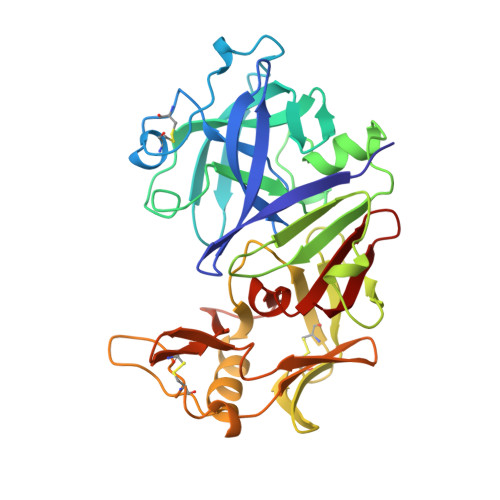A 2.3 A resolution structure of chymosin complexed with a reduced bond inhibitor shows that the active site beta-hairpin flap is rearranged when compared with the native crystal structure.
Groves, M.R., Dhanaraj, V., Badasso, M., Nugent, P., Pitts, J.E., Hoover, D.J., Blundell, T.L.(1998) Protein Eng 11: 833-840
- PubMed: 9862200
- DOI: https://doi.org/10.1093/protein/11.10.833
- Primary Citation of Related Structures:
1CZI - PubMed Abstract:
In the crystal structure of uncomplexed native chymosin, the beta-hairpin at the active site, known as 'the flap', adopts a different conformation from that of other aspartic proteinases. This conformation would prevent the mode of binding of substrates/inhibitors generally found in other aspartic proteinase complexes. We now report the X-ray analysis of chymosin complexed with a reduced bond inhibitor CP-113972 ¿(2R,3S)-isopropyl 3-[(L-prolyl-p-iodo-L-phenylalanyl-S-methyl-cysteinyl)amino-4]-cyclohexy l-2-hydroxybutanoate¿ at 2.3 A resolution in a novel crystal form of spacegroup R32. The structure has been refined by restrained least-squares methods to a final R-factor of 0.19 for a total of 11 988 independent reflections in the resolution range 10 to 2.3 A. The extended beta-strand conformation of the inhibitor allows hydrogen bonds within the active site, while its sidechains make both electrostatic and hydrophobic interactions with residues lining the specificity pockets S4-->S1. The flap closes over the active site cleft in a way that closely resembles that of other previously determined aspartic proteinase inhibitor complexes. We conclude that the usual position and conformation of the flap found in other aspartic proteinases is available to native chymosin. The conformation observed in the native crystal form may result from intermolecular interactions between symmetry-related molecules in the crystal lattice.
Organizational Affiliation:
Department of Crystallography, Birkbeck College, London, UK.


















